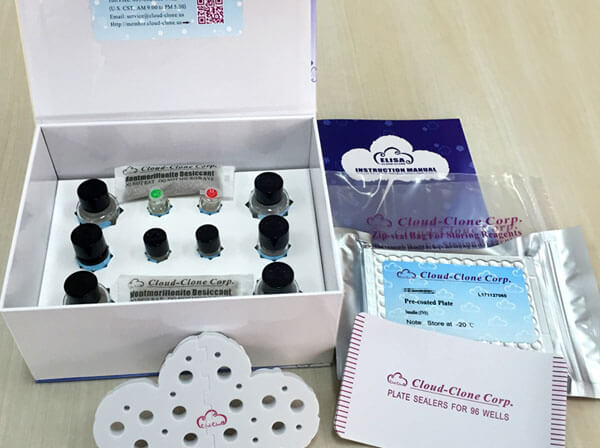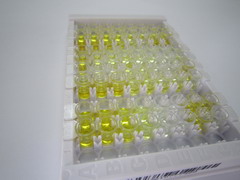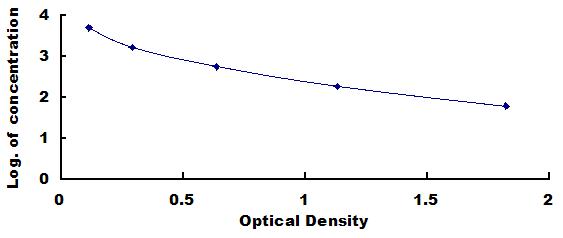ELISA Kit for Hydroxyproline (Hyp) 

(2S,4R)-4-Hydroxyproline; L-Hydroxyproline(C5H9O3N)
- UOM
- FOB US$ 557.00 US$ 796.00 US$ 3,580.00 US$ 6,763.00 US$ 55,692.00
- Quantity
Overview
Properties
- Product No.CEA621Ge
- Organism SpeciesPan-species (General) Same name, Different species.
- ApplicationsEnzyme-linked immunosorbent assay for Antigen Detection.
Research use only - DownloadInstruction Manual
- CategoryMetabolic pathwayNutrition metabolism
Sign into your account
Share a new citation as an author
Upload your experimental result
Review

Contact us
Please fill in the blank.
Recovery
Matrices listed below were spiked with certain level of Hydroxyproline (Hyp) and the recovery rates were calculated by comparing the measured value to the expected amount of Hydroxyproline (Hyp) in samples.
| Matrix | Recovery range (%) | Average(%) |
| serum(n=5) | 85-99 | 94 |
| EDTA plasma(n=5) | 85-98 | 90 |
| heparin plasma(n=5) | 91-105 | 97 |
Precision
Intra-assay Precision (Precision within an assay): 3 samples with low, middle and high level Hydroxyproline (Hyp) were tested 20 times on one plate, respectively.
Inter-assay Precision (Precision between assays): 3 samples with low, middle and high level Hydroxyproline (Hyp) were tested on 3 different plates, 8 replicates in each plate.
CV(%) = SD/meanX100
Intra-Assay: CV<10%
Inter-Assay: CV<12%
Linearity
The linearity of the kit was assayed by testing samples spiked with appropriate concentration of Hydroxyproline (Hyp) and their serial dilutions. The results were demonstrated by the percentage of calculated concentration to the expected.
| Sample | 1:2 | 1:4 | 1:8 | 1:16 |
| serum(n=5) | 85-104% | 97-105% | 93-101% | 93-105% |
| EDTA plasma(n=5) | 87-95% | 97-105% | 78-89% | 84-101% |
| heparin plasma(n=5) | 83-94% | 85-93% | 79-88% | 78-98% |
Stability
The stability of kit is determined by the loss rate of activity. The loss rate of this kit is less than 5% within the expiration date under appropriate storage condition.
To minimize extra influence on the performance, operation procedures and lab conditions, especially room temperature, air humidity, incubator temperature should be strictly controlled. It is also strongly suggested that the whole assay is performed by the same operator from the beginning to the end.
Reagents and materials provided
| Reagents | Quantity | Reagents | Quantity |
| Pre-coated, ready to use 96-well strip plate | 1 | Plate sealer for 96 wells | 4 |
| Standard | 2 | Standard Diluent | 1×20mL |
| Detection Reagent A | 1×120µL | Assay Diluent A | 1×12mL |
| Detection Reagent B | 1×120µL | Assay Diluent B | 1×12mL |
| TMB Substrate | 1×9mL | Stop Solution | 1×6mL |
| Wash Buffer (30 × concentrate) | 1×20mL | Instruction manual | 1 |
Assay procedure summary
1. Prepare all reagents, samples and standards;
2. Add 50µL standard or sample to each well.
And then add 50µL prepared Detection Reagent A immediately.
Shake and mix. Incubate 1 hour at 37°C;
3. Aspirate and wash 3 times;
4. Add 100µL prepared Detection Reagent B. Incubate 30 minutes at 37°C;
5. Aspirate and wash 5 times;
6. Add 90µL Substrate Solution. Incubate 10-20 minutes at 37°C;
7. Add 50µL Stop Solution. Read at 450 nm immediately.

Test principle
This assay employs the competitive inhibition enzyme immunoassay technique. An antibody specific to hydroxyproline has been pre-coated onto a microplate. A competitive inhibition reaction is launched between biotin labeled hydroxyproline and unlabeled hydroxyproline (Standards or samples) with the pre-coated antibody specific to hydroxyproline. After incubation the unbound conjugate is washed off. Next, avidin conjugated to Horseradish Peroxidase (HRP) is added to each microplate well and incubated. The amount of bound HRP conjugate is reverse proportional to the concentration of hydroxyproline in the sample. After addition of the substrate solution, the intensity of color developed is reverse proportional to the concentration of hydroxyproline in the sample.
Giveaways
Increment services
Citations
- Spleen-Derived Interleukin-10 Downregulates the Severity of High-Fat Diet-Induced Non-Alcoholic Fatty Pancreas DiseasePubMed: PMC3532347
- Prediction of fibrosis in hepatitis C patients: assessment using hydroxyproline and oxidative stress biomarkersSpringer: Source
- Royal jelly affects collagen crosslinking in bone of ovariectomized ratsSciencedirect:S1756464614000346
- Tanshinone IIA ameliorates bleomycin-induced pulmonary fibrosis and inhibits transforming growth factor-beta-β–dependent epithelial to mesenchymal transitionPubMed: 25911951
- Theophylline, an old drug with multi-faceted effects: Its potential benefits in immunological liver injury in ratsPubMed: 26165752
- Effects of 4% Icodextrin on Experimental Spinal Epidural Fibrosispdf:JTNEPUB_15079_online.pdf
- Celecoxib attenuates depressive-like behavior associated with immunological liver injury inC57BL/6 mice through TNF-α and NF-κb dependent mechanisms.pubmed:27580523
- Sustained-released mixture of vascular endothelial growth factor 165 and fibrin glue strengthens healing of ileal anastomoses in a rabbit model with …doi.org:10.4174
- Effects of panax notoginseng saponin on the pathological ultrastructure and serum IL‐6 and IL‐8 in pulmonary fibrosis in rabbitsPubmed:29932250
- Renin–angiotensin system inhibition ameliorates CCl-induced liver fibrosis in mice through the inactivation of nuclear transcription factor kappa B10.1139:cjpp-2017-0728
- Pirfenidone suppresses bleomycin‑induced pulmonary fibrosis and periostin expression in rats10.3892:etm.2018.6378
- Therapeutic effect of hepatocyte growth factor-overexpressing bone marrow-derived mesenchymal stem cells on CCl 4-induced hepatocirrhosis.
- The effects of platelet‐rich‐plasma gel application to the colonic anastomosis in hyperthermic intraperitoneal chemotherapy: An experimental rat modelPubmed: 31448554
- Pantoea agglomerans chronic exposure induces epithelial-mesenchymal transition in human lung epithelial cells and mice lungsPubmed: 32146192
- Is platelet-rich plasma improves the anastomotic healing in hyperthermic intraperitoneal chemotherapy with oxaliplatin: an experimental rat studyPubmed: 32051817
- Protective Effects of Contractubex® on Stricture Formation after Experimental Corrosive Esophageal Burns in RatsPubmed: 32654881
- Effect of Oral Channa striatus in Laparotomy Wound Healing of Malnourished Rats.
- Handgrip Strength and Vitamin D as Predictors of Liver Fibrosis and Malnutrition in Chronic Hepatitis C Patients33884041
- Beneficial impact of cathelicidin on hypersensitivity pneumonitis treatment¡ªIn vivo studies33999928
- Curdione and Schisandrin C Synergistically Reverse Hepatic Fibrosis via Modulating the TGF-β Pathway and Inhibiting Oxidative Stress34858986











